For this assignment, we had to create a structure that stood at least six inches above the ground and could hold the weight of a Dixie cup full of pennies. Our group was very focused on the weight element, and we wanted to create the strongest structure possible. We felt a cylindrical structure would be able to support the most weight, similar to how a bunch of sticks manages to hold more force then a single branch could.
We started by constructing a circular base and circular top piece. 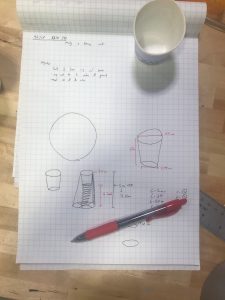 The top piece was made slightly smaller than the circumference the cup’s so that the cup would sit inside the top circle snugly. While we would have preferred to simply wrap the wire around the Dixie cup, the thin, wax-covered paper would not allow us to wrap the copper wire around it due to its fragility. Thus we had to review our basic 6th-grade Geometry skills to determine the circumference of the middle of the cup and make the wire circle within those approximate specifications.
The top piece was made slightly smaller than the circumference the cup’s so that the cup would sit inside the top circle snugly. While we would have preferred to simply wrap the wire around the Dixie cup, the thin, wax-covered paper would not allow us to wrap the copper wire around it due to its fragility. Thus we had to review our basic 6th-grade Geometry skills to determine the circumference of the middle of the cup and make the wire circle within those approximate specifications.
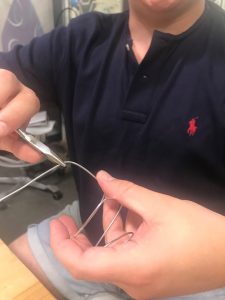 Next we needed to construct a spring to provide additional weight support for the cup. We used the steel for the spring because we found it to be the strongest material of the three. We coiled the spring around a wooden dowel so it was uniform in size throughout. We did this with one piece of the steel wire that we were given and with half of another piece so we could create a spring that comfortably fit between the base and the bottom on the cup. We soldered the two pieces together. The rest of the steel was used to construct the top circle.
Next we needed to construct a spring to provide additional weight support for the cup. We used the steel for the spring because we found it to be the strongest material of the three. We coiled the spring around a wooden dowel so it was uniform in size throughout. We did this with one piece of the steel wire that we were given and with half of another piece so we could create a spring that comfortably fit between the base and the bottom on the cup. We soldered the two pieces together. The rest of the steel was used to construct the top circle.
We used the brass wire to construct the  base. The circle was constructed with the usage of pliers to even out the uneven edges and then proceeded to soldered it shut. We cut some of the brass wire to form an X shape across the base, with the intention of stabilizing the spring, as well as providing a place to officially secure the spring to the rest of our piece. We placed the center of the X in the center of the structure and it was positioned directly under the spring. We soldered the spring to the X in all four spots where the spring touches the X, and the X was soldered to the circular base.
base. The circle was constructed with the usage of pliers to even out the uneven edges and then proceeded to soldered it shut. We cut some of the brass wire to form an X shape across the base, with the intention of stabilizing the spring, as well as providing a place to officially secure the spring to the rest of our piece. We placed the center of the X in the center of the structure and it was positioned directly under the spring. We soldered the spring to the X in all four spots where the spring touches the X, and the X was soldered to the circular base.
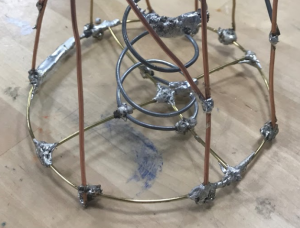 We then soldered on the straight copper and remaining brass wires as supports around the circumference of the base. Unfortunately, the wires did not easily adhere to the solder when you attempted to connect them with simply-flush surfaces. Instead, we had to attempt to wrap the wires around the base. This was an expected problem, considering the circles also did not want to be soldered together; as a result, we had to wrap the wire around itself several times.
We then soldered on the straight copper and remaining brass wires as supports around the circumference of the base. Unfortunately, the wires did not easily adhere to the solder when you attempted to connect them with simply-flush surfaces. Instead, we had to attempt to wrap the wires around the base. This was an expected problem, considering the circles also did not want to be soldered together; as a result, we had to wrap the wire around itself several times.
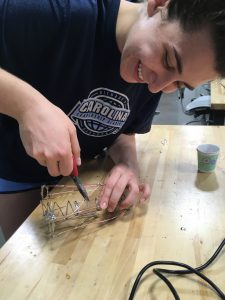 And finally, we added the remaining pieces of wire as decoration on two opposite sides of the structure. We had considerable trouble soldering on the remaining decorative pieces. We found that we were most successful when we laid the structure on its side to solder the remaining metal. When we tried to solder in the decorative side pieces with the structure standing straight up, gravity got in the way and the solder would not adhere to the structure and drip down onto the table. This part of the process also emphasized another element of the metals’ materiality that affected how we worked with it: we noticed that the copper wire heated very quickly, and became difficult to hold without using pliers. Copper’s high rate of heat conduction also affected the solder’s interaction with it; because the copper heated quickly and remained hot for an extended period of time, the solder itself would not easily cool and solidify after being applied to the copper. In a future project—one in which quantity of materials is not restricted—it would help to perform a few tests to determine how different types of metal interact with the solder (gold, for instance, was much more agreeable to the solder than the copper or steel).
And finally, we added the remaining pieces of wire as decoration on two opposite sides of the structure. We had considerable trouble soldering on the remaining decorative pieces. We found that we were most successful when we laid the structure on its side to solder the remaining metal. When we tried to solder in the decorative side pieces with the structure standing straight up, gravity got in the way and the solder would not adhere to the structure and drip down onto the table. This part of the process also emphasized another element of the metals’ materiality that affected how we worked with it: we noticed that the copper wire heated very quickly, and became difficult to hold without using pliers. Copper’s high rate of heat conduction also affected the solder’s interaction with it; because the copper heated quickly and remained hot for an extended period of time, the solder itself would not easily cool and solidify after being applied to the copper. In a future project—one in which quantity of materials is not restricted—it would help to perform a few tests to determine how different types of metal interact with the solder (gold, for instance, was much more agreeable to the solder than the copper or steel).
If we were to try this project again knowing what we do now, 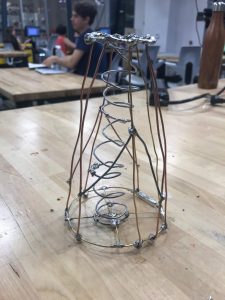 we would likely devise a technique that relies less heavily on solder as an adhesive agent. As we are inexperienced metalworkers, the solder was an effective means of fusing the separate pieces of the structure together—but at a certain aesthetic expense, as the solder does not “disguise” itself amidst the other elements of the piece. Hypothetically, after gaining better control of the soldering tools, we would be able to minimize our use of solder as the fundamental substance that holds the piece together, and therefore reduce the visibility of the piece’s “signs of making,” without sacrificing its structural integrity.
we would likely devise a technique that relies less heavily on solder as an adhesive agent. As we are inexperienced metalworkers, the solder was an effective means of fusing the separate pieces of the structure together—but at a certain aesthetic expense, as the solder does not “disguise” itself amidst the other elements of the piece. Hypothetically, after gaining better control of the soldering tools, we would be able to minimize our use of solder as the fundamental substance that holds the piece together, and therefore reduce the visibility of the piece’s “signs of making,” without sacrificing its structural integrity.